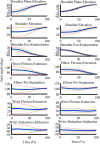Physical Demand but Not Dexterity Is Associated with Motor Flexibility during Rapid Reaching in Healthy Young Adults
- PMID: 25970465
- PMCID: PMC4430491
- DOI: 10.1371/journal.pone.0127017
Physical Demand but Not Dexterity Is Associated with Motor Flexibility during Rapid Reaching in Healthy Young Adults
Abstract
Healthy humans are able to place light and heavy objects in small and large target locations with remarkable accuracy. Here we examine how dexterity demand and physical demand affect flexibility in joint coordination and end-effector kinematics when healthy young adults perform an upper extremity reaching task. We manipulated dexterity demand by changing target size and physical demand by increasing external resistance to reaching. Uncontrolled manifold analysis was used to decompose variability in joint coordination patterns into variability stabilizing the end-effector and variability de-stabilizing the end-effector during reaching. Our results demonstrate a proportional increase in stabilizing and de-stabilizing variability without a change in the ratio of the two variability components as physical demands increase. We interpret this finding in the context of previous studies showing that sensorimotor noise increases with increasing physical demands. We propose that the larger de-stabilizing variability as a function of physical demand originated from larger sensorimotor noise in the neuromuscular system. The larger stabilizing variability with larger physical demands is a strategy employed by the neuromuscular system to counter the de-stabilizing variability so that performance stability is maintained. Our findings have practical implications for improving the effectiveness of movement therapy in a wide range of patient groups, maintaining upper extremity function in old adults, and for maximizing athletic performance.
Conflict of interest statement
Figures









References
-
- Plamondon R, Alimi M. Speed/accuracy trade-offs in target-directed movements. Behav Brain Sci. 1997;20: 279–349. - PubMed
-
- Fitts PM. The information capacity of the human motor system in controlling the amplitude of movement. J Exp Psychol. 1954;47: 381–391. - PubMed
-
- Seidler-Dobrin R, Stelmach G. Persistence in visual feedback control by the elderly. Exp Brain Res. 1998;119: 467–474. - PubMed
-
- MacKenzie C, Marteniuk R, Dugas C, Liske D, Eickmeier B. 3-Dimensional movement trajectories in Fitts Task—Implications for control. Q J Exp Psychol Sect A—Hum Exp Psychol. 1987;39: 629–647.
MeSH terms
LinkOut - more resources
Full Text Sources
Other Literature Sources

